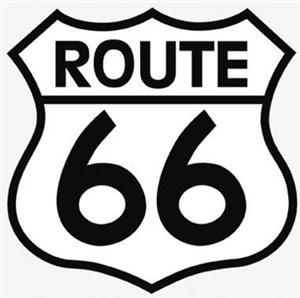May 2009 TRUCKER TALK
THE MOTHER ROAD
BY WRITER & OWNER OPERATOR KIM GRIMM
No road captured America’s love for motoring more than the Old Mother Road herself – Route 66. What started out as a convenient bridge between the East and West turned into a new reason for going. This storied highway did more than move people – it found its way into the hearts of American travelers. The “Main Street of America” joined two metropolitan areas – Chicago and Los Angeles – and breathed life into all of the remote and under-populated cities in between. Unlike the Lincoln, the Dixie, or other highways of the day, Route 66 moved diagonally. Its twisting, meandering path linked hundreds of rural communities, leaving trails of opportunity in its wake.
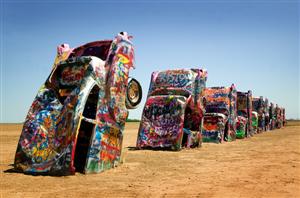 Established on November 11, 1926, Route 66 was one of the original United States highways. Starting at Lake Shore Drive in Chicago, Route 66 made its way through eight states – Illinois, Missouri, Kansas, Oklahoma, Texas, New Mexico, Arizona and California – before coming to an end in Santa Monica, CA at the Pacific Ocean. Along the way, the route passed through cities like St. Louis, Springfield, Oklahoma City, Amarillo, Albuquerque, Flagstaff and Barstow. Cafes, motor lodges, service stations, and neon-blazing tourist attractions dotted the 2,448 miles of magic through three time zones.
Established on November 11, 1926, Route 66 was one of the original United States highways. Starting at Lake Shore Drive in Chicago, Route 66 made its way through eight states – Illinois, Missouri, Kansas, Oklahoma, Texas, New Mexico, Arizona and California – before coming to an end in Santa Monica, CA at the Pacific Ocean. Along the way, the route passed through cities like St. Louis, Springfield, Oklahoma City, Amarillo, Albuquerque, Flagstaff and Barstow. Cafes, motor lodges, service stations, and neon-blazing tourist attractions dotted the 2,448 miles of magic through three time zones.
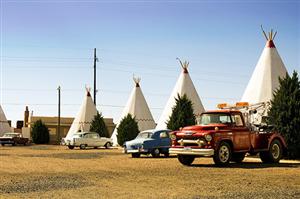 Deserving most of the credit for the idea of promoting an inter-regional link between Chicago and Los Angeles were entrepreneurs Cyrus Avery of Tulsa, OK and John Woodruff of Springfield, MO. It was when their lobbying efforts and dreams merged with a national program for highway and road development that something began to happen. Legislation for public highways first appeared in 1916. In 1925, the federal government began executing its plan for constructing the first national highway system. In the summer of 1926, the Chicago to L.A. route received its “66” designation. Later that year, the highway was opened, but the road signs did not go up until the following year.
Deserving most of the credit for the idea of promoting an inter-regional link between Chicago and Los Angeles were entrepreneurs Cyrus Avery of Tulsa, OK and John Woodruff of Springfield, MO. It was when their lobbying efforts and dreams merged with a national program for highway and road development that something began to happen. Legislation for public highways first appeared in 1916. In 1925, the federal government began executing its plan for constructing the first national highway system. In the summer of 1926, the Chicago to L.A. route received its “66” designation. Later that year, the highway was opened, but the road signs did not go up until the following year.
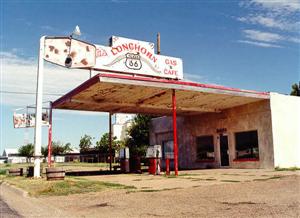 In the early days of Route 66, people traveled in caravans for protection and support. Route 66 was very significant to the early trucking industry. By 1930, trucking had come to rival the railroad for dominance in the American shipping industry. Route 66 became especially appealing to truckers because of its diagonal route, flat desert and prairie lands, and a more temperate climate than the northern highways. And that still holds true today. I’ll be the first to admit, if it’s nice down south and snowing up north, I’ll run the extra miles and take the southern route. But, if the weather is bad in both locations, I’ll save the miles and brave the northern route.
In the early days of Route 66, people traveled in caravans for protection and support. Route 66 was very significant to the early trucking industry. By 1930, trucking had come to rival the railroad for dominance in the American shipping industry. Route 66 became especially appealing to truckers because of its diagonal route, flat desert and prairie lands, and a more temperate climate than the northern highways. And that still holds true today. I’ll be the first to admit, if it’s nice down south and snowing up north, I’ll run the extra miles and take the southern route. But, if the weather is bad in both locations, I’ll save the miles and brave the northern route.
Route 66 was a major path for the migrants who went out West, especially during the Dust Bowl of the 1930s. It is estimated that 210,000 people migrated west to escape the dust storms that were devastating the South. Families already hit hard by the Depression packed up their belongings and headed for a better existence – usually in California. Many of the children of these migrants refer to Route 66 as “the road to opportunity” when telling their stories.
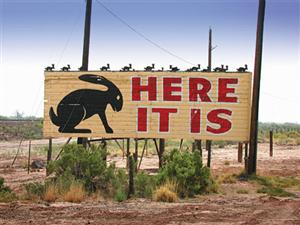 In John Steinbeck’s classic 1939 novel, The Grapes of Wrath, the author proclaimed Route 66 to be “The Mother Road” – and the name (among others) stuck. “And they come onto 66 from the tributary side roads, from the wagon tracks and the rutted country roads – 66 is the mother road, the road of flight.” This name was immortalized even more into the American consciousness when the 1940 film that recreated the book’s epic odyssey was released. Set during the Great Depression, the novel focuses on a poor family of sharecroppers, driven from their home by drought, economic hardship and changes in the agriculture industry. In a nearly hopeless situation, they set out for California along with thousands of other “Okies” in search of land, jobs and dignity.
In John Steinbeck’s classic 1939 novel, The Grapes of Wrath, the author proclaimed Route 66 to be “The Mother Road” – and the name (among others) stuck. “And they come onto 66 from the tributary side roads, from the wagon tracks and the rutted country roads – 66 is the mother road, the road of flight.” This name was immortalized even more into the American consciousness when the 1940 film that recreated the book’s epic odyssey was released. Set during the Great Depression, the novel focuses on a poor family of sharecroppers, driven from their home by drought, economic hardship and changes in the agriculture industry. In a nearly hopeless situation, they set out for California along with thousands of other “Okies” in search of land, jobs and dignity.
 You might say some of the first “rest areas” were along this famous road. Not exactly what we areused to today, but I’m sure they were much appreciated by the people who utilized them back then. These rest areas, called auto camps, were developed when townspeople would rope off spaces in which travelers could camp. Some states employed camp supervisors that would often provide gasoline, wood, water, showers, and sometimes even flushable toilets and laundry facilities free of charge. In the early years, service station prototypes were developed and then later universally adopted across the country. They started out with a simple filling station concept, and then became more elaborate, adding service bays, food and tire sales (sounds familiar).
You might say some of the first “rest areas” were along this famous road. Not exactly what we areused to today, but I’m sure they were much appreciated by the people who utilized them back then. These rest areas, called auto camps, were developed when townspeople would rope off spaces in which travelers could camp. Some states employed camp supervisors that would often provide gasoline, wood, water, showers, and sometimes even flushable toilets and laundry facilities free of charge. In the early years, service station prototypes were developed and then later universally adopted across the country. They started out with a simple filling station concept, and then became more elaborate, adding service bays, food and tire sales (sounds familiar).
After WWII, Route 66 facilitated the relocation of thousands of soldiers and people from the East to the West. This process prompted an ex-marine and former pianist with the Tommy Dorsey Band, Bobby Troup of Harrisburg, PA, to pen the lyrical map of the now-famous “(Get Your Kicks On) Route 66” song. “If you ever plan to motor west. Travel my way take the highway that’s the best. Get your kicks on Route 66!” In 1946, Nat King Cole released the song one week after Troup arrived in Los Angeles. Since then, the song has been recorded by Chuck Berry, The Rolling Stones, Depeche Mode and many others.
From 1960 to 1964, Martin Milner and George Maharis drove into the living rooms of America in the popular TV series called Route 66. The series is best remembered for its iconic Corvette convertible and its instrumental theme song (composed by Nelson Riddle), which became a major hit. The show is well-remembered for its cinematography and location filming. It was one of very few series in the history of television to be filmed entirely on the road. The show, like the highway, created an even deeper mystique of the open road.
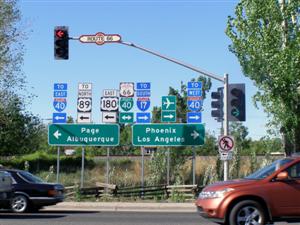 As the American automobile industry began to flourish, the country’s national highway system began to deteriorate and become functionally obsolete, if not dangerous. As life became busier, the slower, more scenic Route 66 began losing its appeal. The hurried world wanted faster, more direct highways. Ironically, what had gained Route 66 its enormous popularity in the early decades came to signal its demise in the mid 1950s. As the public began to lobby for improved thoroughfares and more rapid mobility, President Dwight D. Eisenhower, who had been impressed by the strategic value and efficiency of the Autobahn in Germany, passed the Federal Highway Act of 1956. This act provided the financial umbrella needed to underwrite the construction of the country’s new national interstate and defense highway system.
As the American automobile industry began to flourish, the country’s national highway system began to deteriorate and become functionally obsolete, if not dangerous. As life became busier, the slower, more scenic Route 66 began losing its appeal. The hurried world wanted faster, more direct highways. Ironically, what had gained Route 66 its enormous popularity in the early decades came to signal its demise in the mid 1950s. As the public began to lobby for improved thoroughfares and more rapid mobility, President Dwight D. Eisenhower, who had been impressed by the strategic value and efficiency of the Autobahn in Germany, passed the Federal Highway Act of 1956. This act provided the financial umbrella needed to underwrite the construction of the country’s new national interstate and defense highway system.
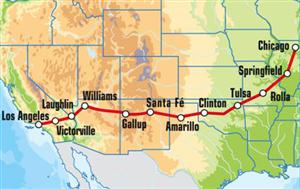 By 1970, Old Route 66 was almost entirely bypassed by modern, four-lane highways. The route ultimately gave way to the interstate system in 1984, when the last vestige of the original road was overtaken by Interstate 40 near Williams, Arizona. On June 27, 1985, US Route 66 was officially removed from the United States Highway System. Today, if you wanted to trace the old route between Chicago and Los Angeles, you would take I-55 south from Chicago to I-44 west, then I-40 west to I-15 south, and then I-10 west to the end. Some parts of the trip might still be scenic, but not nearly as nostalgic as Route 66.
By 1970, Old Route 66 was almost entirely bypassed by modern, four-lane highways. The route ultimately gave way to the interstate system in 1984, when the last vestige of the original road was overtaken by Interstate 40 near Williams, Arizona. On June 27, 1985, US Route 66 was officially removed from the United States Highway System. Today, if you wanted to trace the old route between Chicago and Los Angeles, you would take I-55 south from Chicago to I-44 west, then I-40 west to I-15 south, and then I-10 west to the end. Some parts of the trip might still be scenic, but not nearly as nostalgic as Route 66.
Route 66 was more than just a means to an end, and it was more than just a road – it epitomized the phrase, “Life is a journey, not a destination.” The highway itself and all that it represented (hope, opportunity and adventure), renewed a spirit of optimism that swept across the country after surviving an economic catastrophe and a global war. I can’t think of one road today that might make us feel that way. We don’t think of our highways this way anymore. Instead, we complain about the potholes, traffic and construction closures while cruising along on an air-ride seat. I’ll bet the people who drove on those dirt roads with no windshields and skinny, solid tires wouldn’t have much to complain about with the rides we have today.
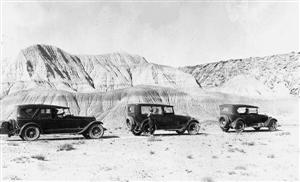 Recently, portions of the old road that passed through Illinois, Missouri, New Mexico, and Arizona were designated as a National Scenic Byway and given the name Historic Route 66. The old route has also begun to return to maps in this form. Some portions of the road in Southern California have also been re-designated as State Route 66, while other sections now bear the Historic Route 66 signs, which include some relevant historic information. This road was a very important part of the most comprehensive westward movement and economic growth period in U.S. history. For that, it should not be forgotten.
Recently, portions of the old road that passed through Illinois, Missouri, New Mexico, and Arizona were designated as a National Scenic Byway and given the name Historic Route 66. The old route has also begun to return to maps in this form. Some portions of the road in Southern California have also been re-designated as State Route 66, while other sections now bear the Historic Route 66 signs, which include some relevant historic information. This road was a very important part of the most comprehensive westward movement and economic growth period in U.S. history. For that, it should not be forgotten.
If you ever get a chance to travel any of the portions of this legendary byway, savor the sights and sounds as you bump along the faded asphalt. Visit some of the now-quiet towns that were once a horn-honking metropolis and find a neon-trimmed burger joint where you can treat yourself to a classic American meal. And, by all means, seek out the people in these towns whose lives and legends are the lore of Route 66. Through their stories, the magic lives on.
